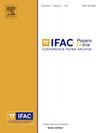电力电子模块热有限元模型的两步模型降阶
Q3 Engineering
引用次数: 0
摘要
了解电力电子器件的热行为在其设计和开发阶段至关重要。典型的功率损耗是损耗>;因此,为了保持可接受的温度,通常需要液体冷却。由于分层设计中的热导率和热容不同,系统具有多个时间常数,不能作为单一时间常数的简单系统进行建模。然而,这种行为可以用有限元方法很好地模拟。瞬态热响应在本例中具有特殊的意义。跨越多个数量级的时间常数需要足够小的时间步长。为了加快仿真速度,可以对原系统进行模型降阶压缩,降低状态维数以获得更高的性能,同时保持仿真结果的良好准确性。在本文中,我们将这些技术应用于典型的电力电子用例,并分析了它们的性能和准确性。我们还讨论了结合两个最先进的软件包的效率和错误边界的两步缩减方案。本文章由计算机程序翻译,如有差异,请以英文原文为准。
Two-step Model Order Reduction for a Thermal Finite Element Model of a Power Electronics Module
Understanding the thermal behavior of power electronics is of critical importance in their design and development stage. Typical power losses are Ploss > 2 kW, thus liquid cooling is often required in order to maintain acceptable temperatures. Due to the different thermal conductivities and heat capacities in the layered design, the system has multiple time constants and can not be modelled as a simple system with one time constant.
However, this behavior can be well simulated using the finite element method. The transient thermal response is of special interest in the present case. Time constants spanning multiple order of magnitudes call for sufficiently small time steps. To speed up simulations, the original system can be compressed with model order reduction, lowering the state dimension to achieve higher performance, while retaining good accuracy of the simulation results. In this contribution, we apply these techniques to a typical power electronics use case and analyze their performance and accuracy. We also discuss a two-step reduction scheme combining the efficiency and error-bound of two state-of-the-art software packages.
求助全文
通过发布文献求助,成功后即可免费获取论文全文。
去求助
来源期刊

IFAC-PapersOnLine
Engineering-Control and Systems Engineering
CiteScore
1.70
自引率
0.00%
发文量
1122
期刊介绍:
All papers from IFAC meetings are published, in partnership with Elsevier, the IFAC Publisher, in theIFAC-PapersOnLine proceedings series hosted at the ScienceDirect web service. This series includes papers previously published in the IFAC website.The main features of the IFAC-PapersOnLine series are: -Online archive including papers from IFAC Symposia, Congresses, Conferences, and most Workshops. -All papers accepted at the meeting are published in PDF format - searchable and citable. -All papers published on the web site can be cited using the IFAC PapersOnLine ISSN and the individual paper DOI (Digital Object Identifier). The site is Open Access in nature - no charge is made to individuals for reading or downloading. Copyright of all papers belongs to IFAC and must be referenced if derivative journal papers are produced from the conference papers. All papers published in IFAC-PapersOnLine have undergone a peer review selection process according to the IFAC rules.
 求助内容:
求助内容: 应助结果提醒方式:
应助结果提醒方式:


